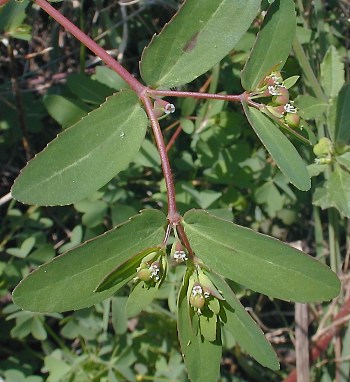Description:
This plant is a summer annual that becomes 3-18" tall; it is low and
spreading, but not prostrate. The stems are pinkish red, round, and
hairless, except for a few fine hairs on new growth. The opposite
leaves are up to 2" long and ¾" across. They are oblong, with short
petioles and margins that are smooth or irregularly serrate. The lower
surface of each leaf is light green, while the upper surface may have a
red blotch in the middle. A few fine hairs may occur near the base of
each leaf. The inflorescence
consists of a small cyathium on a straight
pedicel. Usually, several cyathia develop near the ends of each major
stem when a plant is mature. A cyathium is a small cup-like structure
containing the pistillate flower and one or more staminate flowers,
which have neither true petals nor sepals. It is initially green, but
often turns red in bright sunlight. On this particular species, the
cyathium has 4 tiny petal-like appendages that are bright white.
Eventually, a round tripartite fruit develops from the cyathium on a
short stalk; it often turns red in bright sunlight as well. This fruit
is noticeably larger than the flowers. The blooming period is
mid-summer to fall, lasting about 1-2 months. There is no noticeable
floral scent. The root system consists of a slender central taproot.
leaf. The inflorescence
consists of a small cyathium on a straight
pedicel. Usually, several cyathia develop near the ends of each major
stem when a plant is mature. A cyathium is a small cup-like structure
containing the pistillate flower and one or more staminate flowers,
which have neither true petals nor sepals. It is initially green, but
often turns red in bright sunlight. On this particular species, the
cyathium has 4 tiny petal-like appendages that are bright white.
Eventually, a round tripartite fruit develops from the cyathium on a
short stalk; it often turns red in bright sunlight as well. This fruit
is noticeably larger than the flowers. The blooming period is
mid-summer to fall, lasting about 1-2 months. There is no noticeable
floral scent. The root system consists of a slender central taproot.
Cultivation:
The preference is full sunlight, dry conditions, and poor soil. The
soil can contain significant amounts of gravel, sand, or clay. Foliar
disease rarely bothers the leaves, and drought resistance is excellent.
This plant can reseed itself readily in sunny open areas.
Range & Habitat:
The native Nodding Spurge is a common plant that occurs in nearly every
county of
Illinois (see Distribution
Map). Habitats include dry upland areas of prairies, clay
prairies, gravel prairies, thickets, openings in upland
woodlands, fields and pastures (whether abandoned or still in use),
areas along roadsides and railroads, poorly maintained lawns and
gardens, and miscellaneous waste areas. This plant prefers disturbed
open areas and it is somewhat weedy. This plant seems to be more common
in rural
than urban areas, possibly because of its intolerance to herbicides and
frequent mowing of lawns.
Faunal
Associations:
The tiny flowers occasionally attract small bees, Syrphid flies, and
wasps. These insects seek nectar primarily. The seeds are consumed by
the Mourning Dove and Greater Prairie Chicken, and to a lesser extent
by the Bobwhite and Horned Lark. The Wild Turkey has been known to eat
the foliage, developing buds, and fruits, apparently without ill
effects. Mammalian herbivores rarely eat this plant because of the
poisonous white latex in the stems and foliage.

Photographic
Location:
The photographs were taken at the Windsor Road Prairie in Champaign,
Illinois. Some flowers are in bloom in one of the photographs as their
stamens are clearly visible.
Comments:
The Nodding Spurge can be readily distinguished from other Chamaesyce
spp. by its more erect habit, larger leaves, and mostly
hairless stems. Several scientific names have been applied to the
Nodding Spurge in the past, including Chamaesyce
maculata, Euphorbia maculata, and Euphorbia
preslii. Sometimes the entire plant will turn reddish green
in response to strong sunlight and dry conditions.